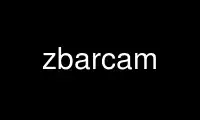
This is the command zbarcam that can be run in the OnWorks free hosting provider using one of our multiple free online workstations such as Ubuntu Online, Fedora Online, Windows online emulator or MAC OS online emulator
PROGRAM:
NAME
zbarcam - scan and decode bar codes from a video device
SYNOPSIS
zbarcam [-qv] [--quiet] [--nodisplay] [--xml] [--verbose[=n]] [--prescale=WxH]
[-S[symbology.]config[=value]] [--set [symbology.]config[=value]] [device]
zbarcam {-h | --help | --version}
DESCRIPTION
zbarcam scans a video4linux video source (eg, a webcam) for bar codes and prints any
decoded data to the standard output. The video stream is also displayed to the screen.
device is the path to the video4linux (version 1 or 2) character device special file
(major number 81 and minor number 0 thru 63). It defaults to /dev/video0
The underlying library currently supports EAN-13 (including UPC and ISBN subsets), EAN-8,
Code 128, Code 39, and Interleaved 2 of 5 symbologies. The specific type of each detected
symbol is printed with the decoded data.
OPTIONS
This program follows the usual GNU command line syntax. Single letter options may be
bundled, long options start with two dashes (`-´).
-h, --help
Print a short help message describing command line options to standard output and exit
--version
Print program version information to standard output and exit
-v, --verbose[=n]
Increase debug output level. Multiple -v options create more spew. Alternatively
specify n to set the debug level directly
-S[symbology.]config[=value], --set [symbology.]config[=value]
Set decoder configuration option config for symbology to value. value defaults to 1
if omitted. symbology is one of ean13, ean8, upca, upce, isbn13, isbn10, i25, code39,
code128 or the special value *. If symbology is omitted or *, the config will be set
for all applicable symbologies. These are the currently recognized configs. Prefix a
config with "no-" to negate it. Not all configs are appropriate for every symbology.
enable
Control decoding/reporting of a symbology. For symbologies which are just subsets
of ean13 (upca, upce, isbn13, isbn10), this config controls whether the subsets
are detected and reported as such. These special cases are disabled by default,
all other symbologies default to enabled
disable
Antonym for enable
emit-check
Control whether check digits are included in the decoded output. Enabled by
default. This config does not apply for code128, which never returns the check
digit. It also not apply for cases where the check digit is disabled (see
add-check). Check digits are currently not implemented for i25 or code39
add-check
Enable decode and verification of a check digit for symbologies where it is
optional: this will include code39 and i25, neither of which implements the check
digit yet
ascii
Enable escape sequences that encode the full ASCII character set. This would apply
to code39, except that it´s not implemented either...
position
Enable collection of symbol position information. Enabled by default. Currently,
the position information is unusable, so you can save a few cycles by disabling
this.
min-length=n, max-length=n
Bound the number of decoded characters in a valid symbol. If a decode result is
outside the configured min/max range (inclusive), it will not be reported. Set to
0 to disable the corresponding check. This setting applies to variable-length
symbologies: i25, code39, code128 and pdf417. min-length defaults to 6 for i25
and 1 for code39 (per Code 39 autodiscrimination recommendation); all others
default to 0
x-density=n, y-density=n
Adjust the density of the scanner passes. Lower values scan more of the image at
the cost of decreased performance. Setting to 0 disables scanning along that axis.
Defaults are both 1.
-q, --quiet
Quiet operation; disable the audible beep otherwise emitted when a symbol is decoded
--nodisplay
Disable output video window. Video input will be scanned until the program is
interrupted or otherwise signaled
--xml
Stream results using an XML output format. This format wraps the raw data from the
symbol with information about the scan in an easy to parse format. The latest schema
is available from http://zbar.sourceforge.net/2008/barcode.xsd
--raw
Use raw symbol data output format. This format prints symbol data separated by
newlines without the additional symbology type information that is printed by default
--prescale=WxH
Request video input scaling from the camera driver. Possibly useful for reducing huge
frames to achieve a higher frame rate. Note that the driver may adjust or completely
ignore the scaling request
EXAMPLES
Scan for barcodes using the second video device and pipe the resulting data through a
script that searches for each code in a database and does something useful with them:
zbarcam /dev/video1 | upcrpc.py
The upcrpc.py example script included in the examples/ subdirectory of the distribution
will make an XMLRPC call to a popular internet UPC database and print the product
description if found.
Scan for barcodes using the default video device and stream results to stdout in XML
format, also disable recognition of Interleaved 2 of 5 codes to prevent confusion with
other symbologies or background noise:
zbarcam --xml -Si25.disable
Scan only for Code 39, without using the preview window - maybe for a fixed installation.
To enable only Code 39, first all symbologies are disabled, then Code 39 is re-enabled:
zbarcam --nodisplay -Sdisable -Scode39.enable
Use zbarcam online using onworks.net services
